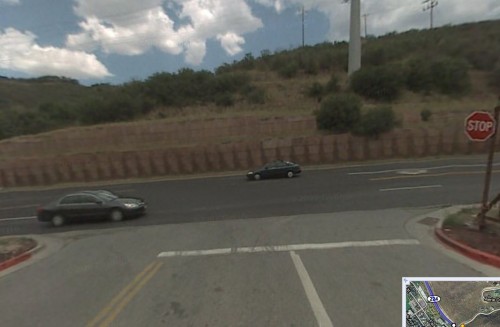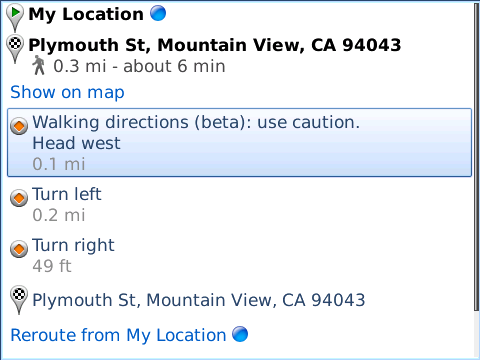Searched, but may be old, lock, mock, etc if that is the case.
http://news.cnet.com/8301-17852_3-20006379-71.html
Original article with lots of pics and the filing here:
http://searchengineland.com/woman-follows-google-maps-walking-directions-gets-hit-sues-43212
And an update was posted here:
http://searchengineland.com/attorney-in-google-maps-lawsuit-43349
Yeah yeah, wall of text, but I added some pictures! Seems like personal responsibility is a dying concept judging from some of the comments.
Seems like personal responsibility is a dying concept judging from some of the comments.
http://news.cnet.com/8301-17852_3-20006379-71.html
Why trust the machines when you can trust your own eyes, your own brain, your own basic sense of survival?
This philosophical question comes to mind after reading the tragic tale of a woman, her eyes, her brain, her BlackBerry, and her Google Maps.
According to an exhaustive analysis presented by Search Engine Land, Lauren Rosenberg decided to take a walk in Park City, Utah, on January 19, 2009.
I will try and ignore just how fundamentally un-American this act was in order to focus on some of the ensuing action.
Rosenberg fingered her trusted BlackBerry and asked it to tell her just how she might walk between 96 Daly Avenue and 1710 Prospector Avenue. Her BlackBerry turned to the world's great walking resource, Google Maps. Google Maps suggested that she should, as part of her journey, amble along Deer Valley Drive.
For all of you who have not had the pleasure of strolling there, might I quote papers filed by Rosenberg's lawyers with the Utah courts. These papers describe Deer Valley Drive as "a.k.a. State Route 224, a rural highway with no sidewalks, and a roadway that exhibits motor vehicles traveling at high speeds, that is not reasonably safe for pedestrians."
There is perhaps nothing finer than a roadway that bothers to exhibit motor vehicles. Yet this was not quite the exhibition that Rosenberg had in mind. For during her stroll along State Route 224 aka Deer Valley Drive she was allegedly struck by a car driven by Patrick Harwood.
She's suing Harwood. And she is also suing Google.

The contentious route. Note the warning. But that's on the laptop version.
(Credit: Screenshot: Chris Matyszczyk)
Perhaps some of you might think of Rosenberg as just a perambulating chaser. Yet she and her lawyers reason that Google's walking directions were "careless, reckless, and negligent providing of unsafe directions."
Now this is the point at which your complex minds become engaged and my rather simpler version becomes divorced. You see, if you ask Google Maps for walking directions on your laptop you get a very clear warning--yes, on one of those lovely beigey-yellow backgrounds--that reads: "Walking Direction are in Beta. Use caution--This route may be missing sidewalks or pedestrian paths."
The question is, does this warning appear when you go to Google Maps on your BlackBerry? Or, even more importantly, on Rosenberg's BlackBerry? It does not appear to appear on the iPhone. Which might suggest the same situation holds with the RIM phone.
What I cannot ascertain from the court papers is why Rosenberg would want to walk this route in Utah. She is, it appears, from Los Angeles, which means that she might not have been used to walking at all.
Equally puzzling is the first part part of the court papers where it is says that Rosenberg suffered mental, physical and emotional injuries that caused her to incur medical expenses "in an amount yet to be determined." And yet when it comes to the part about suing Google, medical expenses are said to exceed $100,000.
Courts have not always been sympathetic to those who claim that they were merely following the orders of enlightened machines. There was the man in England who ordered his BMW down an unpaved cliffside lane, got stuck, and then claimed that his GPS made him do it. The court decided it was the driver's own brain that made him do so.
Can Rosenberg expect Utah courts to be more sympathetic? In our world of increasingly diminished responsibility, might someone actually be in a position to prove that we are all now subjects of the Googleplex? Those Googlies have filmed our streets, made records of our Wi-Fi data, followed us around the Web until they could offer us ads that are "good" for us. Shouldn't we admit whose the supreme power truly is?
Or might the judge emit a cough and declaim in the finest Latin: "Caveat walker"?
Original article with lots of pics and the filing here:
http://searchengineland.com/woman-follows-google-maps-walking-directions-gets-hit-sues-43212
And an update was posted here:
http://searchengineland.com/attorney-in-google-maps-lawsuit-43349
Ive spoken to the lead attorney in the case involving the woman who blames Google, in part, for directing her onto a highway where she was struck by a vehicle. Expressing amazement at the firestorm of attention the case has garnered, he explained some of the reasoning putting some of the blame on Google.
Our prior story, Woman Follows Google Maps Walking Directions, Gets Hit, Sues, covers how Lauren Rosenberg was struck by a vehicle as she walked between two locations in Park City, Utah. Using her BlackBerry phone, shed used Google Maps and its walking directions feature to generate a route. Those directions sent her down Deer Valley Drive, an alternative name for Utah State Route 224. She was struck on that highway.
My key question for her attorney, Allen K. Young of firm Young, Kester & Petro, was the same that many reading about the case seem to have. Didnt she know the road was unsafe for pedestrians, as she started walking on it?
It was 6 in the morning. It was not a busy street [then]. She believed there was a sidewalk on the other side, Young said.
In fact, Rosenberg never reached the other side. She left the end of Main Street to cross to the far side of Deer Valley Drive / State Route 224 and was struck while crossing. Heres a view of the intersection from Google Maps:

She was in an area that shed never been to before. It was pitch black. There were no street lights. She relied on Google that shed cross there and go down to a sidewalk, Young said.
Ironically, had Rosenberg not been directed to cross, she could have continued along the route walking against traffic but separated from it on a dirt path, Young said. Thats part of the reason for the suit claiming Google to be partially at fault.
Google had shots of the corner there. Had they looked at that, they would have realized, Young said.
The shots Young is talking about are the Street View street-level photography such as shown above. Of course, Google doesnt actually review the Street View photography to determine if a walking route that it plots is safe. Instead, to my knowledge, it uses an algorithm to make a best guess based on known walking paths and other data. As Google wrote when announcing the service in July 2008:
Walking directions are a new feature for Google, and while Im pretty excited about it, there are some rough edges that compel us to release it in beta. Walking directions work well for short trips in urban areas, but we dont always know if a street has a sidewalk, or if theres actually a special pedestrian bridge for crossing a busy street. There are still a lot of pedestrian pathways we dont know about, and they might save you some time if you find them. Were working on collecting new data on pedestrian pathways and on more effective ways to solicit your feedback, so that we can steadily improve this feature and get you where you need to be as efficiently as possible .
. Please be careful, and be particularly attentive in high traffic areas. Just like if you were driving, follow road signs and signals along your route, and use good judgment about streets that cant be walked (there are many useful websites containing safety tips for pedestrians).
Still, Google does offer the service. And as I wrote on Friday, perhaps it would be better off not offering walking directions that can be so wrong, rather than generating embarrassing misdirections or worse, as has happened now, opening itself up to legal action.
We look at it and say if theyre [Google] going to tell people where to go, they need to have some responsibility to warn them that that might not be the way to go, Young said.
Google does currently warn that walking directions are in beta and to:
Use caution This route may be missing sidewalks or pedestrian paths.
However, these are only for directions generated by those using its regular web site. Those using mobile versions of Google Maps, dont appear to get such warnings. When I tested on Friday using my iPhone, I didnt see a warning. Young also said his client got no warning on her BlackBerry when she was hit, on January 19, 2009. He also said that back then, Google did not offer warnings on its regular site.
Im not sure when or why Google apparently belatedly added warnings to Google Maps. Im still waiting to hear back from Google on that and some other questions.
Young said that in Utah, a jury can find against a plaintiff even if they are deemed only partially responsible. So perhaps a jury will find Google to be only 5% at fault in the accident, for example. If so, the Google would be responsible for that much of any claim, if Rosenberg should win, Young said. The case seeks at least $100,000 in damages
But still, isnt there a role for common sense? The intersection itself had no crosswalk, as Young himself admits. Shouldnt Rosenberg herself have some responsibility to judge where it was safe to walk or cross?
I have told everyone that I think a jury will find some culpability on her part, Young said as well as some on the part of the driver the suit says hit her, and Google itself.
As for the case itself, he expressed amazement over the amount of interest and commentary it has generated.
Ive not spoken with Google. I merely filed the complaint. I had no idea the firestorm it would cause, Young said.
Young is also set to give a statement to the press tomorrow at 9am Utah time at the Salt Lake City law offices of Snow, Christensen & Martineau. That law firm isnt connected with the case. Young is simply making use of a conference room there.
Postscript: Heard back from Google PR now, which tells me via email:
We have had warning text since launch July 08 on desktop, November 08 on mobile. Due to screen real estate, the mobile beta warning is a bit shorter, but it says Walking directions (beta): Use caution and usually shows up with the first step in your directions list.
Heres an example of how the warning looks to BlackBerry users, from a screenshot Google sent to me:

This is why I missed spotting the directions when I checked my iPhone. I was expecting them to somehow appear next to the route itself, on the map. Instead, it appears as you click to see the text instructions of the route.
Google also told me they know of no other lawsuits of this type that have ever been served against them. As for comments on the case itself, I was
We havent been served yet, so we cant comment on the specific merits, but in general we offer the beta warning as an extra indication that users should exercise caution and judgement and we also, on desktop, have an additional note below directions that they are for planning purposes only (ie, we do not tell you to stop at red lights or not drive in a carpool-only lane).
Yeah yeah, wall of text, but I added some pictures!
